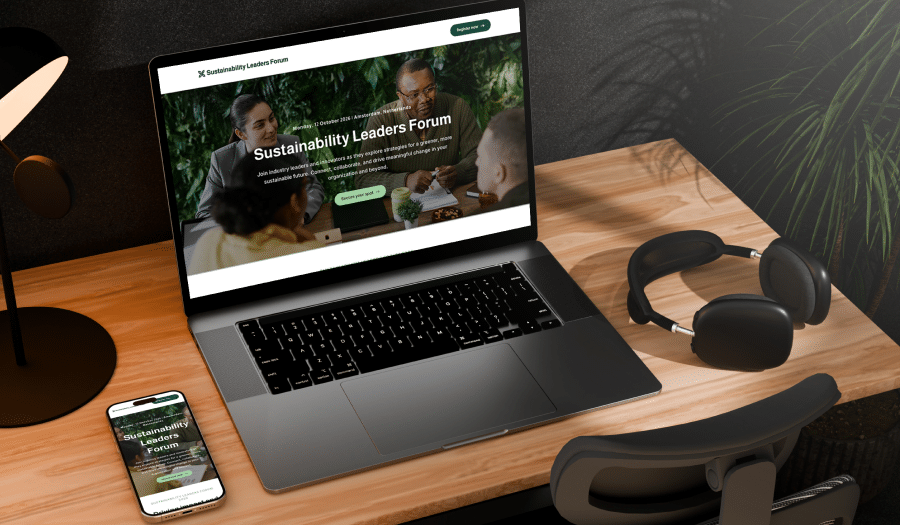
In the world of events, lead management tools and services have existed for many years, and until recently the processes and technology hadn’t changed much. It wasn’t so long ago that many of us were still using the good old fishbowl method – collect business cards, give away swag and hand the leads off to the sales team for follow-up.
Thankfully, things have changed very quickly in the last couple of years. The rise in popularity of hybrid events and virtual audiences since 2020 has been a game changer for events lead management, because the systems and processes to manage the event are underpinned by the collection of digital data.
Coupled with the exploding popularity of cloud-based technologies, lead management companies and event management platforms are also evolving. With real-time connectivity via the cloud, exhibitors now expect real-time access to not only basic lead details but deeper profiles and marketing data.
Our definitive guide to lead management for professional event organizers takes you through everything you need to know – what it is, the benefits, the five major steps of lead management and how to do it successfully. Most importantly, we’ll provide some essential advice on making the right choices if you’re looking for a new lead management system for your next event.
What is lead management?
Lead management is a broad term to describe the collection or capturing of leads at trade shows or exhibitions, and what you do with those leads after they have been acquired.
So, what’s the difference between lead capturing and lead management, and why is this important to today’s technology-savvy meeting organizers?
What is the difference between lead capturing and lead management?
Lead capturing simply refers to the collection of leads. It is the first step of the lead management process.
Lead management refers to the holistic process of how you capture and organize that data to maximize your follow-up sales processes. It includes a number of critical steps, outlined below, including:
- Lead enrichment and tracking
- Lead qualification
- Lead distribution
- Lead nurturing.
The benefits of lead management
There are numerous benefits to proper lead capture and management of events data, and these include:
- Drive outcomes after the event. Whether your KPIs are tied to sales or some other measure, correct lead management goes a long way to help you achieve your post-event goals.
A recent study by Exhibitor magazine concluded that up to 40% of leads collected at events do not get followed up. In other words – it was a waste of time and resources to even collect them in the first place. By simply having a system in place to follow up leads after your event, you’ll already be ahead of many of your competitors (but the work doesn’t stop there).
- Build a clearer picture of your audience. An integrated lead management solution will help you develop a clearer and more detailed picture of your target audience(s) over time. Entire teams, whether they are at the show or not, are able to view lead collection in real time, instantly export details and track where the leads are coming from (geographically).
You’ll get an even better unified picture if you’re able to integrate your events lead management system with your customer relationship management system (CRM). This way, you can report and track lead effectiveness, all the way through to closed sale or disqualification, on a show by show basis.
- Empower your exhibitors. If you are able to incorporate lead management as part of your sponsorship offering, your exhibitors will appreciate being able to collect leads with their smart devices, ask pertinent profile questions and make sure the prospect receives a follow up email immediately and automatically after they depart from the stand or booth.
- Build a new revenue stream. The benefits of disciplined lead management can be passed along to exhibitors, who will appreciate near-instant access to both basic lead details along with expanded answers to specific profile questions. Alternatively, you may prefer to charge for advanced features as another revenue stream.
What are the five major steps of lead management?
Step 1: Lead capturing
Lead capturing simply refers to the collection of leads. This could happen prior to the event (e.g. via your website or EDM promotions), during the event (e.g. at an exhibitor’s stand) or post-event (during a post-event survey or request for more information).
Step 2: Lead enrichment and tracking
Your first interaction with a prospect typically only allows you to capture a few basic pieces of information – for example, their name, organization and email address. Beyond this, you’ll want to create a more detailed picture of each prospect, based on publicly available information such as their job title, location, timezone, company name and social media profiles. Some lead management solutions can also track a lead’s activity on your website.
This is all valuable data that will help to personalize future marketing efforts and initiate targeted follow-up activities down the track.
Step 3: Lead qualification
Lead qualification is the process of predicting the likelihood of a lead turning into a customer, or completing whatever action you want them to. One way to do this is through contact scoring, which ranks your leads based on various factors including their interest and engagement with your company, their demographics and various actions they might take throughout their buying journey. Many lead management software packages for events will do this automatically, using technologies such as artificial intelligence.
Lead qualification allows you to then prioritize your sales and marketing efforts and make sure you’re investing time and effort in the right areas.
Step 4: Lead distribution
This step refers to how the leads are assigned to various members of the sales team for follow-up. Again, you want this process to be as automated as possible, as it can be highly time-consuming if done manually.
Step 5: Lead nurturing
Not all your leads will be ready for the sales team – some will need to be nurtured after the event, often for a few months before they’re ready to convert. By nurturing your leads you can keep them interested and engaged with your company throughout the sales cycle. This often involves sending them useful and interesting content, following up with phone calls and making sure they’re receiving targeted and personalized EDMs.
Best practices of lead management
Lead management after the event is often more an art than a science. That being said, there are a few general tactics to keep in mind to ensure you’re staying on top of things:
- Automate wherever you can. Good lead management software packages will offer numerous opportunities to automate parts of the process – from qualification, to distribution, to nurturing and more.
- Follow up, follow up, follow up. If you tell your leads they’re going to hear from you, make sure they do. By the same token, don’t go overboard and send them too much information!
- Nurture to add value. Some sales information throughout the nurturing process is okay, but you should also be adding value with helpful content and interesting information. Keep sending your leads this valuable content throughout the process and even after you’ve closed the sale – this is how customers turn into advocates! (Unless they opt out or unsubscribe from your mailings, of course.)
- Measure what you’re doing. This is the only way you’ll be able to make better decisions going forward.
How to choose a lead management system
We hope by now you’re convinced of the usefulness of a good lead management system for your next event. If you’re looking for a new solution, keep the following points in mind:
- Tailored to the events industry: There are thousands of leads management packages available, but only a handful are really suitable for serious event planners. Make sure you ask about the tailored capabilities for events management before you purchase.
- Flexible and scalable: This is particularly important if you manage a wide range of events with different requirements.
- Easy to use: If you’re not a marketing expert, make sure you look for lead management systems that automate as much of the process as possible, and are user-friendly.
- Cost: Investigate up-front and extra costs. Ideally your lead management system will come free or packaged as part of your events management solution.
Trends in lead management
The world of lead management is evolving every day. However, there are a few key trends we expect to see more of in the months and years ahead:
- Lead generation will continue towards full digitalization, with limited manual intervention
- More use of video conferencing, chatbots and live chat in the lead nurturing process
- Increasing use of automation and artificial intelligence in the lead management process.
How can our event management software help to improve your next event?
At EventsAir, we understand the importance of selecting the right event technology partner – someone who can help you deliver the best event possible, whether virtual, hybrid or in-person. Our solutions also include lead management technology at no additional cost – to help you get the most out of your event data.
We have one simple mission: to help event planners deliver the WOW in their events with the world’s most powerful event management technology. We’ve delivered some of the world’s biggest events, and we’d love to help you too.
Reach out to request a demo, and one of our team members will be in touch shortly.
Event Data & Analytics | Event Technology & Apps | Lead Capture | Sponsors & Exhibitors
See EventsAir in action
Discover why 12,000+ event professionals trust EventsAir to deliver effortless events, every time.




